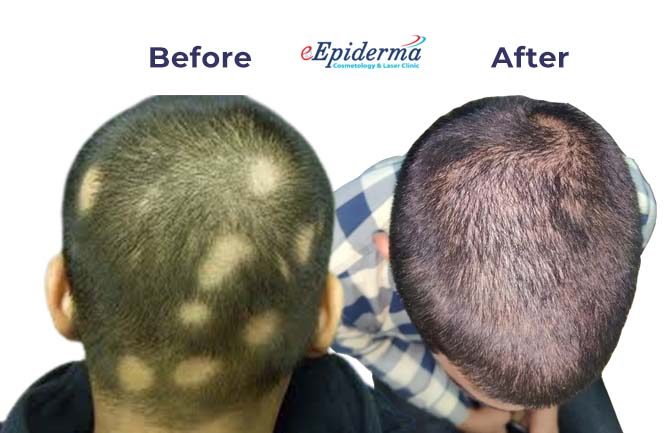

Hair loss has become a common problem nowadays due to reasons like stress, genetic issues, weather conditions, etc. It’s important to treat your hair loss problems, but for the right treatment, it’s necessary to know the real cause behind them. There are many types of hair loss, and alopecia areata, also known as bald patches, is one of the problems with hair loss that needs to be treated. So, let’s discuss alopecia areata in detail:
Alopecia areata is an auto-immune disease that makes your hair fall out in clumps or sometimes in quarters. 1. Alopecia areata is divided into four types:
1. Alopecia areata totalis, where you lose all the hair from your head,
2. Alopecia areata universalis, where you lose hair of your entire body,
3. Diffuse alopecia areata makes the hair thin over time.
4. Ophiasis Alopecia Areata, which results in bald patches on your head
The symptoms you might notice if you have alopecia areata include:
1. You might notice small bald patches on your scalp as well as on other body parts.
2. The bald patches might grow larger over time.
Sometimes the hair grows back in a particular spot only.
3. Your fingernails and toenails become red and breakable.
Alopecia areata occurs anywhere on your body, which includes:
1. Scalp,
2. Eyebrows,
3. Eyelashes,
4. Armpits,
5. Area of your beard, etc.
Alopecia Areata can be treated, and you can grow your hair back with a protein or biotin treatment, which acts as a vitamin for your hair. At first, red light therapy is given, which uses laser light to give radiation rays into the tissues of the scalp, encouraging hair growth on the weak cells by the absorption of the rays from light. After the light therapy process, micro-channeling is done for hair growth into the scalp.
This helps to renew damaged hair follicles and improve the collagen of the skin. Through the micro-channeling process, the circulation of blood increases, which helps to improve the follicles, thus providing nutrients needed for hair growth. At the end, protein or biotin is injected into the scalp through injections because applying biotin-containing products cannot help with absorption, which is why injecting biotin directly is useful. It helps the scalp grow new, healthy hair while also preventing hair dryness and making the hair stronger from the roots.
You need to do at least 4 sessions to stop hair fall problems. After that, 7-8 sessions are needed in total to see a visible result by noticing the improvement in hair texture; also, the hair will look shiny and smooth. But you need to do the treatment again if your doctor has prescribed it.
Yes, biotin is a safe procedure that anyone suffering from bad hair conditions or hair loss can definitely use.
There are some possible side effects, which include:
1. You might experience trouble sleeping,
2. Rashes in skin is possible,
3. Digestion problem.
After the protein/biotin treatment, you are likely to notice your hair fall problems are reducing, as well as new and thick hair.
You need to apply shampoo and oil solutions as per the advice prescribed by the doctor. You are also advised to take supplements for hair that will be taken according to your condition of hair that your doctor can advise properly.
Therefore, in conclusion, Alopecia areata is a hair condition that can happen to people of any age, and it is important to treat your hair loss condition at any cost because nothing should impact our self-confidence, not even hair loss. So, without any doubt, choose Epiderma Cosmetology and Laser Clinic, where you can get a wide range of skin types treated with our advanced and ultra-modern laser technologies.
